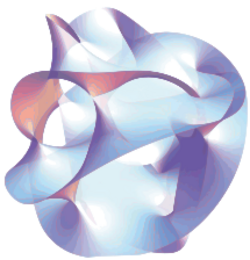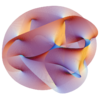Physics:Matrix string theory
From HandWiki
Short description: Set of equations that describe superstring theory in a non-perturbative framework
| String theory |
|---|
 |
| Fundamental objects |
| Perturbative theory |
| Non-perturbative results |
| Phenomenology |
| Mathematics |
In physics, matrix string theory is a set of equations that describe superstring theory in a non-perturbative framework. Type IIA string theory can be shown to be equivalent to a maximally supersymmetric two-dimensional gauge theory, the gauge group of which is U(N) for a large value of N. This matrix string theory was first proposed by Luboš Motl in 1997[1] and later independently in a more complete paper by Robbert Dijkgraaf, Erik Verlinde, and Herman Verlinde.[2] Another matrix string theory equivalent to Type IIB string theory was constructed in 1996 by Ishibashi, Kawai, Kitazawa and Tsuchiya.[3]
See also
References
- ↑ L. Motl, "Proposals on nonperturbative superstring interactions". arXiv:hep-th/9701025.
- ↑ R. Dijkgraaf, E. Verlinde, H. Verlinde, "Matrix String Theory", Nucl. Phys. B 500, p. 43 (1997) arXiv:hep-th/9703030.
- ↑ N. Ishibashi, H. Kawai, Y.Kitazawa, A. Tsuchiya, "A large-N reduced model as superstriing", Nucl. Phys. B 498 p. 467 (1997) arXiv:hep-th/961211517521.
 |


